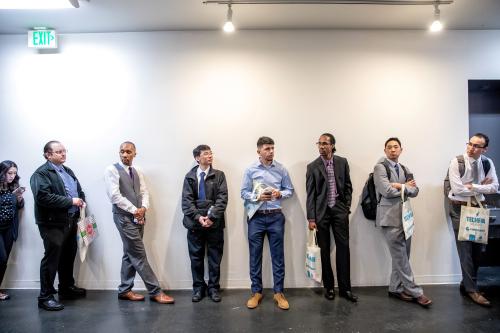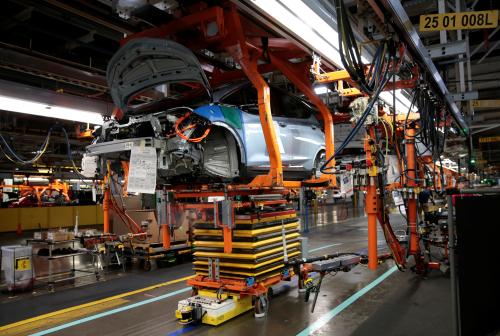This op-ed was originally published in Newsweek on November 20, 2019. It is based on findings contained in a new research volume, edited by the authors and published by the Russell Sage Foundation.
At least to some extent in last Wednesday’s Democratic debate, and more so in the earlier ones, candidates have offered soundbites touting crowd-pleasing “silver bullet” proposals to raise earnings and reduce inequality among US workers.
To improve workers’ skills, Bernie Sanders and Elizabeth Warren call for free college for all. To raise wages, many call for a rapid increase in the federal minimum wage to $15 an hour as well as resurgent unionism. And Andrew Yang continues to call for “universal basic income” in response to potentially large-scale job displacement from automation.
But no single silver bullet solution exists that can solve our skills and earnings problems. Why? Because no single or dominant cause explains stagnating earnings or rising inequality in the US. Thus, simplistic “silver bullet” policies would likely be ineffective or even do more harm than good.
Some “silver bullets” are too scattershot. For instance, free college for all would shunt billions of dollars of tax revenue into subsidizing higher education for the wealthy at a time when federal budgets are already deeply in the red. A Universal Basic Income would be even more expensive, and could induce workers to stop seeking many new jobs that will be created over time.
Other proposals could harm those they aim to help or be ineffective. Imposing a uniform $15 federal minimum wage, even by 2025 (as many now propose), could induce employers to eliminate jobs for low-wage workers in already distressed communities. Proposals to expand unionism alone might generate only small increases, in light of employers’ ability of to resist collective bargaining by automating, relocating their facilities, or outsourcing work to other firms.
To sensibly raise wages and reduce inequality among American workers, we must recognize that a confluence of causes are at work, which requires a combination of evidence-based policy responses. The causes include labor market forces like technical change, globalization, and too few well-educated workers; they also include changes in labor institutions beyond weakened unions and a lack of worker “voice.” Indeed, a growing set of employer practices, such as outsourcing some activities to other firms (which is often called employment “fissuring”) likely contribute to weak outcomes as well. Such practices break the time-honored links between a firm’s profitability and its workers’ earnings, and diminish employer interest in training workers to make them more productive.
Without important, systematic policy changes, the earnings and employment of US workers – especially those without college degrees – will likely continue to deteriorate. More trade and automation in the form of robotics and artificial intelligence (AI) will almost certainly lead millions of workers to be displaced, while our failure to adequately fund public institutions of higher education and workforce services will limit workers’ readiness for new jobs that will be created. In other areas – including federal wage and hour laws, worker rights to representation on the job, and employer staffing arrangements – we are surely still moving in the wrong direction.
Furthermore, we are failing to address important needs of specific groups whose labor force participation has actually weakened in recent years. Women (as well as men) fail to get the child care assistance and paid leave they need to hold jobs when major family responsibilities arise; disadvantaged youth lack access to the work experience and training, especially at community colleges, that could raise their earnings and encourage work activity. And many less-educated men – especially African Americans – remain scarred by criminal records that too often deter employers from hiring them. Indeed, weak earnings and employment now force more workers to depend on informal work to bolster what they earn in the regular job market, even though these informal jobs come with few legal protections.
Accordingly, a robust future for the US will require not one or two “silver bullets” but a suite of policies that both support innovation and protect workers. Strong evidence supports the following policies: (1) more funds for higher education and workforce services that provide non-college pathways to the middle class; (2) protecting workers’ rights to collectively bargain or express their “voice” in worker councils; (3) updating our federal wage and hours laws; (4) providing paid family leave and quality childcare options for working parents; (5) opportunities for better training and work experience for youth; and (6) helping workers who face barriers like criminal records or substance abuse reenter the labor market while we reform our criminal justice system. All of these steps must be underpinned by (7) improved labor market information, experimentation, and ongoing policy evaluations.
While soundbites and silver bullets proposals generate much of the buzz in an election year, improving worker earnings in the US will instead require a suite of sensible policy choices. Legislating these policies in our polarized political environment will be very challenging. But ultimately this comprehensive approach to the stagnation of worker wages and rising inequality will be vastly more effective than any promised single solution on its own.
The authors did not receive financial support from any firm or person for this article or from any firm or person with a financial or political interest in this article. Neither of the authors is currently an officer, director, or board member of any organization with an interest in this article.








Commentary
Op-edHelping workers requires more than silver bullets
November 25, 2019